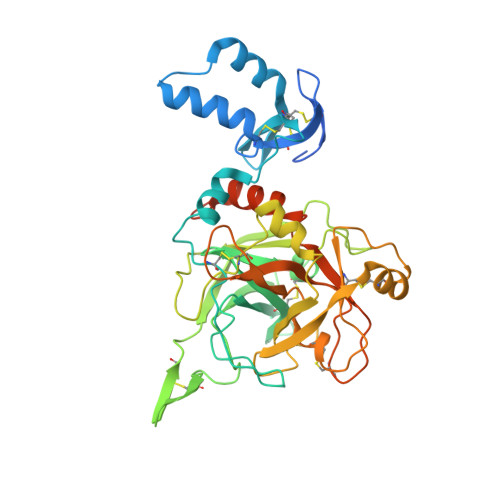Structure-Function Analysis of Grass Clip Serine Protease Involved in Drosophila Toll Pathway Activation.
Kellenberger, C., Leone, P., Coquet, L., Jouenne, T., Reichhart, J.M., Roussel, A.(2011) J Biol Chem 286: 12300
- PubMed: 21310954
- DOI: https://doi.org/10.1074/jbc.M110.182741
- Primary Citation of Related Structures:
2XXL - PubMed Abstract:
Grass is a clip domain serine protease (SP) involved in a proteolytic cascade triggering the Toll pathway activation of Drosophila during an immune response. Epistasic studies position it downstream of the apical protease ModSP and upstream of the terminal protease Spaetzle-processing enzyme. Here, we report the crystal structure of Grass zymogen. We found that Grass displays a rather deep active site cleft comparable with that of proteases of coagulation and complement cascades. A key distinctive feature is the presence of an additional loop (75-loop) in the proximity of the activation site localized on a protruding loop. All biochemical attempts to hydrolyze the activation site of Grass failed, strongly suggesting restricted access to this region. The 75-loop is thus proposed to constitute an original mechanism to prevent spontaneous activation. A comparison of Grass with clip serine proteases of known function involved in analogous proteolytic cascades allowed us to define two groups, according to the presence of the 75-loop and the conformation of the clip domain. One group (devoid of the 75-loop) contains penultimate proteases whereas the other contains terminal proteases. Using this classification, Grass appears to be a terminal protease. This result is evaluated according to the genetic data documenting Grass function.
Organizational Affiliation:
Architecture et Fonction des Macromolécules Biologiques UMR6098, Parc Scientifique et Technologique de Luminy, 13288 Marseille Cedex 09, France. Christine.Kellenberger@afmb.univ-mrs.fr

















